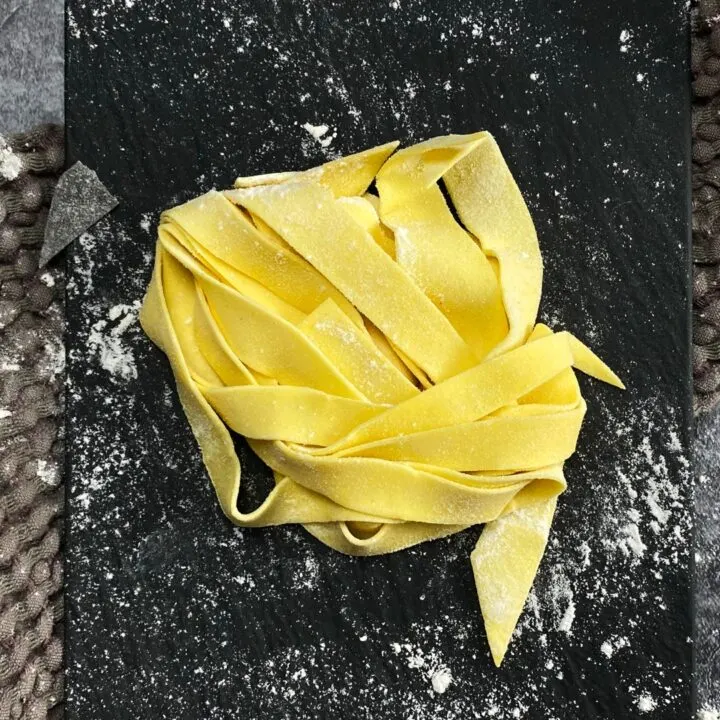This article will teach you how to make homemade semolina pasta step by step.
This basic recipe is perfect for fettuccine, but you can also use it for other types of pasta, such as orecchiette, cavatelli, and maccheroni.
First, I’ll show you how to make tagliatelle with Italian pasta dough without egg and which traditional recipes go perfectly with it.
After that, you’ll find instructions for more advanced types of pasta, as well as tips for cooking, storing, and drying pasta made from durum wheat (semolina)
⬇ Pin it for later!

How to Make Semolina Pasta at Home (By Hand)
The pasta dough with durum wheat without egg is particularly at home in southern Italy.
It is the most common recipe for pasta and consists of 2 simple ingredients: Durum wheat and water.
The high protein content of durum wheat ensures that the dough is elastic after kneading and resting.
Best Recipe for Pasta with Semolina:
4 Servings
- 14 ounces (400 g) of durum wheat flour (semola di Grano Duro, rimacinata)
- 7 ounces (200 ml) of hot water
- 1/2 tsp (4 g) of salt
(Find my exact product recommendations in the recipe card)
You can find other recipes for semolina dough in the following article:
Step 1: Form the flour into a well and gradually add water.
Empty the flour onto the work surface and form a hollow in the middle.
Slowly pour the hot water into the center of the well and mix it with the flour using a fork.

Step 2: Form the crumbly mass into a lump with your hands and knead for 10 minutes.
Press the crumbly mass into a lump of dough and knead it for at least 10 minutes.
Do not add any more water! The dough may appear dry, but the kneading will gradually incorporate all the flour into the dough.

Step 3: Continue kneading until all the flour is incorporated into the dough.
There are several kneading techniques, one of which I find particularly compelling:
Apply forward pressure to the dough with the heel of your hand. Pull the dough back with the other hand, turning it slightly, about 45°. Repeat the process until all the dough crumbs are incorporated.
If, after 10 minutes of kneading, there is still flour on the work surface, add a (tiny!) amount of water to the dough (I use a flower sprayer for this). The remaining flour should then be easy to work into it.
If you need help with this step, you can find tips against brittle pasta dough here.

Step 4: Wrap the pasta dough in plastic wrap and let it rest at room temperature for 30 minutes.
It is ready only when the pasta dough has a smooth, silky surface and no longer sticks.
Then you have to let it rest for 30 minutes, wrapped airtight. To do this, wrap the dough as airtight as possible in plastic wrap and place it away from direct light to rest.
During the resting time, the gluten network inside the dough will rearrange itself, and the dough will become more elastic.

Step 5: Cut a piece of the pasta dough and press it into a disc.
When I use 400 to 600 grams of flour, I cut the dough in half because it’s easier to work with that way.
I then press the dough half flat with the heel of my hand and roll it out paper-thin with a rolling pin.

Step 6: Roll out into a 1-millimeter thin pasta sheet.
The dough sheet should be at most 1 millimeter for ribbon noodles. A good indicator that you reached the required thickness is when the work surface becomes visible through the dough.
Here is how you can roll out the dough:
Place the rolling pin in the center of the dough disk and stretch it forward in a short, wave-like motion.
Then rotate the disc about 45 degrees and repeat the process. If the dough sticks, sprinkle it with a bit of flour.
Tip: as soon as the dough disk is somewhat larger, pull it towards you across the work surface so that a third protrudes. It makes it easier on your back because you don’t have to lean so far forward. On top of that, the dough stretches more quickly due to gravity.

Step 7: Fold the pasta dough several times and cut it into strips.
You completed a significant part of the work. Now you have to shape the noodles.
To make ribbon noodles, fold the dough into itself several times. It makes it easy to get evenly shaped noodles.
Tip: I let the dough dry on both sides for about 5 minutes before folding it. This way, I ensure that the noodles can be formed into nests afterward without sticking together.
If the dough sheet is still sticky, sprinkle it with flour. Otherwise, the noodles will weld together when you cut them, and you’ll have to separate them individually by hand.

With a sharp knife, I divide the pasta at regular intervals (about 1 centimeter for tagliatelle).
Lastly, a little trick: before you cut the pasta, turn the pasta sheet so that one end is facing up. It will make it easier to form the pasta nests because you can grab the tagliatelle all at once (see Figure 24).
Step 8: Grab the ends of each noodle and form nests out of them.
Whether you want to dry the pasta, freeze it, or use it right away: Forming pasta nests is the best way to store them temporarily to save space.
Hold the ends of the pasta in one hand and wrap the pasta once around with the other hand, as shown in the pictures.

You get delicious fettuccine!
Beautiful.

Now you have several options. You can:
- Cook the homemade pasta
- Freeze the fresh pasta
- Dry the pasta and store it for a long time
Note that fresh pasta cooks much faster than dried. Usually, 2 to 3 minutes is enough.


Best Homemade Semolina Pasta (Step by Step)
This article will teach you how to make homemade semolina pasta step by step.
This basic recipe is perfect for fettuccine, but you can also use it for other types of pasta, such as orecchiette, cavatelli, and maccheroni.
First, I'll show you how to make tagliatelle with Italian pasta dough without egg and which traditional recipes go perfectly with it.
After that, you'll find instructions for more advanced types of pasta, as well as tips for cooking, storing, and drying pasta made from durum wheat (semolina)
Ingredients
- 14 ounces (400 g) of durum wheat flour (semola di Grano Duro, rimacinata)
- 7 ounces (200 ml) of hot water
- 1/2 tsp (4 g) of salt
Instructions
- Form the flour into a well and gradually add water.
- Form the crumbly mass into a lump with your hands and knead for 10 minutes.
- Continue kneading until all the flour is incorporated into the dough.
- Wrap the pasta dough in plastic wrap and let it rest at room temperature for 30 minutes.
- Cut a piece of the pasta dough and press it into a disc.
- Roll out into a 1-millimeter thin pasta sheet.
- Fold the pasta dough several times and cut it into strips.
- Grab the ends of each noodle and form nests out of them.
Nutrition Information:
Yield: 4 Serving Size: 1Amount Per Serving: Calories: 1593Total Fat: 4gSaturated Fat: 1gTrans Fat: 0gUnsaturated Fat: 2gCholesterol: 0mgSodium: 98mgCarbohydrates: 334gFiber: 12gSugar: 1gProtein: 45g
